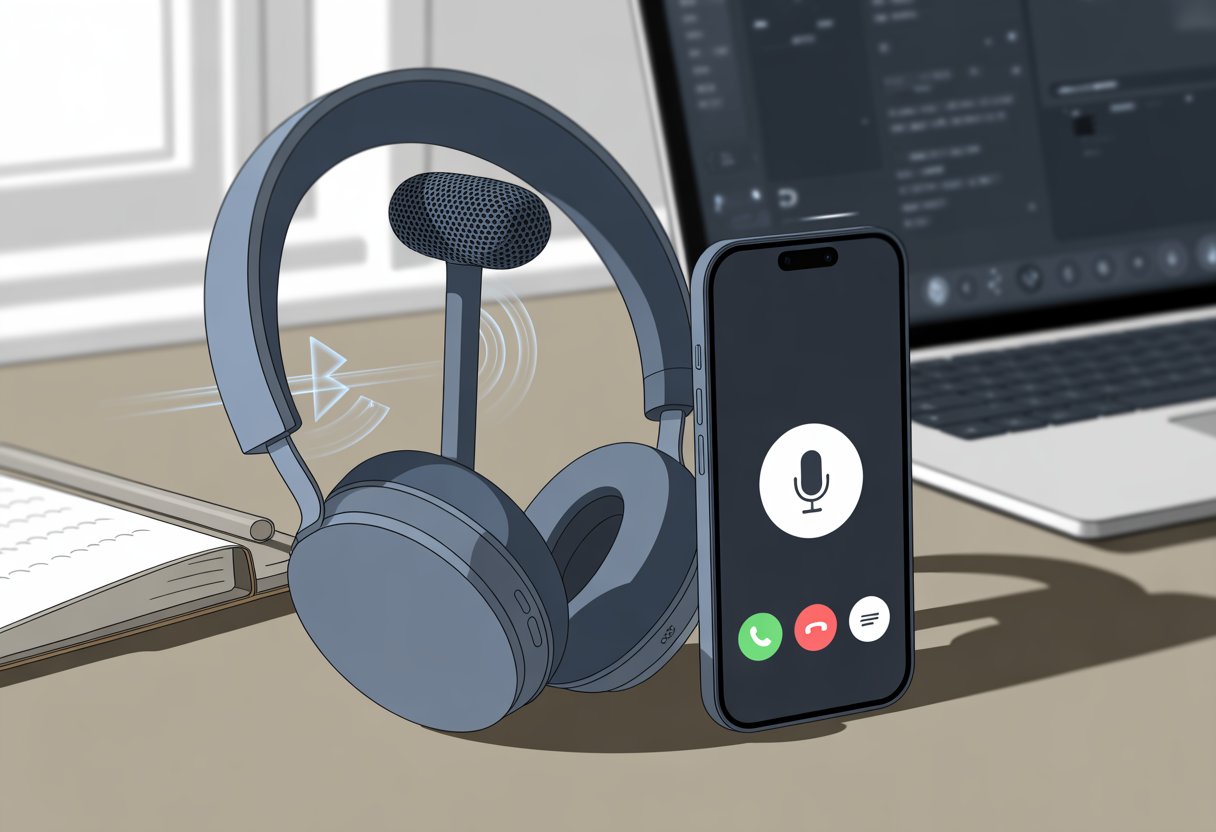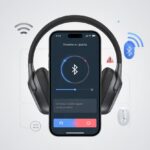We’ve all been there: you grab your Bluetooth headset, ready for a call, and the microphone decides it’s on strike. Suddenly, you’re waving at your screen, hoping someone can read lips. Usually, the microphone on our Bluetooth headphones doesn’t work because the device isn’t using the right input, or the headset is stuck in the wrong mode.

Sometimes, it’s just a setting we forgot to check. Maybe Windows or macOS is playing tricks on us. Other times, privacy settings or a weird pairing process can trip us up when we least expect it.
If you’re tired of yelling, “Can you hear me now?” into the void, let’s walk through some common fixes and tips to get your headset talking again.
Common Causes for Bluetooth Headphone Microphone Issues
When Bluetooth headphone microphones go silent, there’s usually a reason. Sometimes it’s a sneaky setting, a Bluetooth connection that’s lost its way, or hardware that’s just plain tired.
Incorrect Default Audio Device
Honestly, Windows and Mac like to mess with us. Even with wireless headphones connected, the computer might ignore them and stick with its built-in microphone.
Open sound settings, and you’ll probably find your computer trying to use a different device—maybe even something random like a webcam mic. We have to manually pick our Bluetooth headset from the list.
To fix it, click the speaker or mic icon, head to “Sound Settings,” and select your Bluetooth headset for both output and input. Sometimes, that tiny check mark is all it takes to go from mute to meeting-ready.
Need more help? There are some decent guides on troubleshooting Bluetooth mic setup.
Bluetooth Connection Problems
Bluetooth can be a bit flaky. Your computer and headphones may say they’re connected, but the pairing might have failed behind the scenes. Interference from other gadgets, a dying battery, or outdated drivers can all mess things up.
Try re-pairing the device—just disconnect and reconnect. Make sure your Bluetooth drivers are up to date, and close any extra Bluetooth connections floating around. Windows, in particular, gets confused if you’ve connected a bunch of audio devices.
Resetting or unpairing and pairing again often does the trick. If not, run the built-in troubleshooter or check for updates, like in this Bluetooth mic troubleshooting guide.
Hardware Malfunctions
Sometimes, the hardware is just done. If your headphones have survived a few drops or a coffee spill, the microphone might have quietly retired.
Test your headset on another device. If the mic still doesn’t work, it probably needs fixing or replacing. For those with detachable cables or plug-in mics, try unplugging and plugging them back in.
If you’re singing into your headphones and still getting nothing, it might be time to think about warranty claims—or, if you’re brave, opening them up (and hoping you don’t end up with leftover screws).
How to Fix Microphone Not Working on Bluetooth Headphones
When your Bluetooth headset microphone refuses to work, it’s frustrating. Thankfully, there are a few things you can try before you lose your cool.
Checking Microphone Permissions
Sometimes, your Bluetooth headset isn’t the problem—your device is just blocking it. Microphone permissions can hide out in your computer or phone’s settings.
Go to Settings, look for Privacy or App Permissions (on Windows, it’s under Settings > Privacy > Microphone). Make sure your favorite apps are allowed to use the microphone.
On Mac, check System Preferences > Security & Privacy > Microphone and confirm your apps have access. Don’t forget to check Bluetooth settings too; toggling the switch off and on sometimes fixes things, almost like giving your system a quick nap.
Permissions can change after a system update, so it’s worth double-checking. If everything looks fine, try unpairing and pairing again to refresh permission settings.
Updating Device Drivers
If your computer feels stuck in the past, drivers might be the issue. They’re like translators between your headset and the system, and sometimes they just stop working after an update.
On Windows, open Device Manager, find “Bluetooth,” and right-click your Bluetooth headphones (or check under “Audio inputs and outputs”). Choose “Update driver.” An internet connection helps Windows find the latest version.
If that doesn’t work, check the manufacturer’s website for new drivers. Outdated drivers can make the microphone stop working, even if you can still hear sound.
Sometimes, uninstalling the drivers and restarting your computer will force it to reinstall the right one. That move works more often than you’d think.
Pairing and Re-Pairing Headphones
Bluetooth can get moody. Your headset may look paired, but the mic just isn’t joining in.
First, unpair the device from your computer or phone. On Windows, go to Bluetooth & Devices > Devices, find your headset, and click “Remove Device.” On phones, tap the “i” next to the device and hit “Forget.”
After that, put the headset in pairing mode (usually by holding the power button) and reconnect. This fresh connection can wake up the microphone.
Sometimes, the mic only starts working after a full pairing reset. Maybe it just needed a moment alone. Who doesn’t?
If you’re having trouble, toggle Bluetooth off and on for both devices. That usually clears up minor bugs.
Restarting Devices
The classic restart—because sometimes, that’s all it takes. Turn off your Bluetooth headset, power down your computer or phone (not just sleep mode), and wait about twenty seconds.
Turn everything back on and reconnect your headset. Stubborn microphone problems often disappear after a reboot.
If you’re still stuck, go back to checking drivers or permissions, but don’t underestimate the magic of a restart. It’s a fresh start for you and your mic.
Bluetooth Headphone Microphone Troubleshooting Tips
Bluetooth headphone microphones have a mind of their own sometimes. When the mic isn’t working, a few simple tweaks can save you from silent calls and endless headaches.
Switching Between Audio Profiles
Bluetooth headphones love their audio profiles. Yours might be in “Stereo” or “High Quality Audio,” which sounds great for music but usually disables the mic. To use the microphone, you’ll need to switch to “Hands-Free” or “Headset” mode.
Here’s how:
- Right-click the sound icon on your Windows taskbar and go to Sound settings.
- Look for Input or Recording devices and pick your Bluetooth headphones as the mic.
- Select the “Headset” or “Hands-Free” profile, not “Stereo” or “Headphones.”
The sound quality might drop, but at least people can hear you. If you want to dive deeper into Bluetooth profile headaches, check out this adventure with switching profiles.
Testing With a Different Device
Sometimes, the problem isn’t your headset or your computer—it’s just a weird combination. Before you throw your gear in frustration, try connecting your Bluetooth headphones to another device, like a phone or tablet.
If the mic works there, your PC probably needs a driver update or some settings adjusted. If it still doesn’t work, the headphones are likely the issue.
Testing with another device narrows things down fast and saves you a ton of time.
Turning Off Other Wireless Devices
Bluetooth gets cranky when there’s too much going on nearby. If your mic keeps cutting out, other wireless gadgets might be interfering.
Try this:
- Turn off or move away from other Bluetooth, Wi-Fi, or wireless dongles.
- Keep your headphones and computer close together.
- Unplug any extra USB receivers or smart devices nearby.
Clearing the area can help your Bluetooth signal breathe. If you’re still having trouble, a reboot of everything (including yourself) might do the trick. For more tips, this microphone troubleshooting guide is handy.
Special Considerations for iPhone Users
iPhones can be picky, let’s be real. When your Bluetooth headset mic acts up, it’s usually not personal—it’s just Apple being Apple.
There are a few key settings to check if you want to actually talk instead of mime through your calls.
iOS Audio Settings
Let’s be honest—the settings menu can be a real culprit here. When our Bluetooth headset connects but the microphone gives us the cold shoulder, we need to head over to Settings > Bluetooth. We’ll spot that tiny “i” next to our headset’s name. Tap it, hit “Forget This Device,” and reconnect. Weirdly enough, this trick works more often than you’d expect.
If that doesn’t do the trick, our iPhones might still act stubborn. We should check which microphone the phone’s actually using, whether it’s for calls, Siri, or voice notes.
Choosing the Bluetooth microphone for audio input can really save the day. And, honestly, keeping iOS updated is a must—those bugs seem to love messing with Bluetooth.
Still stuck? Sometimes dirt hides in the headphone jack, or the phone thinks wired headphones are plugged in. A quick clean can help.
If things still aren’t working, try Settings > General > Reset > Reset All Settings—and maybe cross your fingers for good luck. If you want a step-by-step, Apple’s support page is worth checking out if our microphones aren’t working.
App-Specific Microphone Access
Apps can be weirdly possessive. Sometimes they just forget to ask for microphone permissions. Every app—WhatsApp, Zoom, FaceTime—needs us to allow Bluetooth headset mic access.
Let’s check Settings > Privacy & Security > Microphone. We can toggle on permissions for the apps we actually use.
If an app’s still not listening, the problem might hide in its own settings. Some apps require us to dig around and enable Bluetooth mic access there too.
Skip this step and our headphones become nothing more than fancy earmuffs.
Also, we should keep an eye on iOS updates. Updates sometimes reset app permissions and suddenly the mic stops working.
If nothing helps, deleting and reinstalling the app can work wonders. We shouldn’t let a stubborn app keep us from chatting just because it forgot our headset exists.
When to Replace or Repair Your Wireless Headphones
Let’s be real—sometimes wireless headphones just give up, especially when the mic decides it’s done. Before we buy new ones or reach for a screwdriver, it’s smart to figure out what actually broke and what the warranty covers.
Identifying Irreparable Damage
First thing: check for damage that no amount of rebooting will fix. If the headband snapped, wires poked out, or the mic survived a washing machine cycle, that’s usually the end.
If our headphones won’t charge, don’t show up on any device, or the mic stays silent after trying everything, these issues might be deal-breakers.
Broken buttons, crackling audio, or the classic “one earcup working, one sulking” are all warning signs.
Here’s a quick checklist for serious damage:
| Problem | Fixable? |
|---|---|
| Snapped headband | Sometimes |
| Water inside mic port | Unlikely |
| Battery won’t charge | Rarely |
| Constant disconnects | Maybe |
If several of these apply, it’s probably time to let go.
Warranty and Support Options
Before tossing them, let’s see if our headphones are still under warranty. Most brands offer at least a one-year warranty for defects or mic failures that aren’t our fault.
Some companies give extra coverage if we registered the product or paid with a credit card that offers protection.
It’s always worth reaching out to support. Sometimes they’ll walk us through fixes we haven’t even tried yet.
We should have this info ready when contacting them:
- Purchase receipt or proof of purchase
- Headphone model and serial number
- Description of the microphone problem
If the headphones aren’t covered, a professional repair might cost as much as buying new ones. In that case, it’s probably smarter (and less of a headache) to start looking for a replacement.
Improving Audio Quality During Calls
Nobody wants to sound like they’re calling from inside a fish tank. For better Bluetooth audio and mic quality, we need to control background noise and keep our headphones close to the device.
Minimizing Background Noise
Honestly, it’s like pets and construction crews know when we’re on a call. Too much background noise makes the mic sound like it’s picking up a zoo.
Noise-cancelling headphones help, but even without them, there are a few tricks:
- Pick a quieter room—ideally one where the cat isn’t doing laps at midnight.
- Shut doors and windows to keep out outside noise.
Muting ourselves when we’re not talking is a lifesaver. Nobody wants to hear us sneeze in high-def.
Make sure apps like Zoom or Teams are set to “suppress background noise.” Some call it “background noise reduction” in their settings.
If things get desperate, putting a soft cloth near the mic (without covering it!) can actually cut down on chaos a bit.
Adjusting Bluetooth Range
Ever notice how our audio quality just tanks when we walk too far from the device? Bluetooth only goes so far—usually about 30 feet.
But honestly, walls or even a suspiciously thick sandwich can mess with it. If we wander out of range, the mic often cuts out, or our voice just sounds like a robot for no good reason.
Here’s what actually helps:
- Keep devices within 10 feet if you can. It’s a pain, but it works.
- Don’t let thick stuff—bookshelves, fridges, whatever—get between you and your phone or computer.
- Make sure your headphones aren’t stuck in “headset” or “hands-free” mode. That setting kills audio quality when the mic’s on. There’s more about that in this Reddit thread about Bluetooth headset audio dropping.
And if all else fails, standing on tiptoes and whispering “Bluetooth, please work” almost never helps. Just keep your gear close—trust me, it’s way less frustrating.
- Why is my fitness tracker not pairing with Apple Health? Troubleshooting for Technologically Cursed Mortals - December 22, 2025
- Why is my fitness tracker not updating firmware? Tech Tantrums and Update Woes Explained - December 21, 2025
- Why is the Sound Quality on My Bluetooth Headphones Poor? It’s Not Just Bad Music Taste! - December 21, 2025






